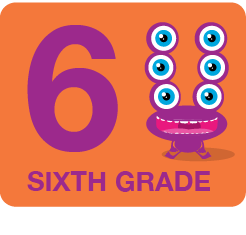Let's practice prime and common factors! Page 1 features five hungry factor fish, each needing a different amount of fish flakes. There are multiple ways to split the food. Can you find them all? Page 2 explores two methods for prime factorization. Can you complete the exercises? Next, on page 3, help these meatball-loving aliens figure out the greatest common factors. Finally, on pages 4 and 5, Granny Gertie is busy making quilts and needs your help to figure out the sizes of quilt squares and cubes. Lend a hand so she can take her morning walk with her friend, Gigi Jeannine. Wait! They walk at different speeds. Can you figure out how long it will take them to meet again at the bridge?
The first two pages practice prime factorization. Prime factorization breaks down composite numbers into their prime number components, which are the building blocks of all numbers. Kids will be introduced to and practice two different methods to find a number's prime factorization: the factor tree method and the division method.
On the third page, kids practice finding a number's GCF. They first need to find the factors for each of two numbers and then figure out which number is the greatest among the two groups. The greatest common factor (GCF) of two numbers is the largest number that can divide both of them without leaving a remainder. It is helpful because it helps us simplify fractions and solve problems where we need to divide things into equal parts. For example, knowing the GCF can make those tasks much easier when you want to distribute candies evenly or when trying to figure out the optimal size for cutting pieces of ribbon without having leftovers.
The last two pages of this workbook focus on squares and cubes. Imagine you have a number, like 2. If you "square" it, multiply it by itself, so 2 squared is 2 times 2, which equals 4. It's like making a small square with a side length of 2. Now, if you "cube" the number, you multiply it by itself twice, so 2 cubed is 2 times 2 times 2, which equals 8.
Fun with Factors: Prime and Common Factor Workbook
GRADES:


Additional Educational Resources:
Whole Number Multiplication and Division Large Workbook - (Grade 5)
Three-Dimensional Shapes Large Workbook - (Grade 5)
Order of Operations (Grade 6 - Math Assessment)
Whole Numbers (Grade 5 - Math Assessment)

